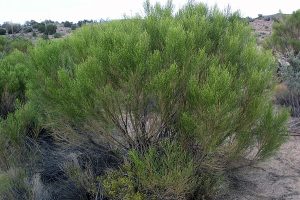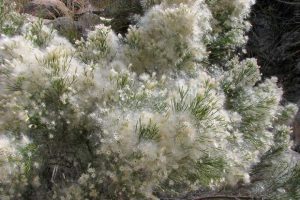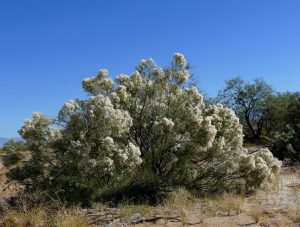Desert Broom (Baccharis sarothroides): A Resilient California Native Plant
Introduction
Desert Broom (Baccharis sarothroides), a hardy and drought-tolerant California native plant, is a prominent member of the coastal sage scrub and desert ecosystems throughout the southwestern United States. This resilient shrub is known for its distinctive appearance, adaptability, and essential role in supporting local wildlife and conserving soil stability.
Appearance
Desert Broom typically grows to a height of 3 to 10 feet, with some specimens reaching up to 15 feet. Its slender, upright branches are covered in small, needle-like leaves that give the plant a feathery appearance. The leaves are an attractive gray-green color, which helps reduce water loss through transpiration. In late summer and early fall, the shrub produces small, inconspicuous flowers that are an important nectar source for pollinators, including bees and butterflies.
Habitat and Range
This native Californian plant is well adapted to arid and semi-arid regions, making it a common sight in the desert and coastal areas of California, Arizona, and parts of Nevada and Mexico. Desert Broom thrives in full sun and well-drained soils, often colonizing disturbed areas, roadsides, and hillsides.
Ecological Significance
Desert Broom plays a crucial role in its ecosystem. Its deep root system helps stabilize soil, preventing erosion in vulnerable desert landscapes. Additionally, the plant provides valuable food and habitat for a variety of wildlife species. Insects, such as the desert swallowtail butterfly, rely on its nectar for sustenance, while birds find shelter among its branches.
Drought Tolerance
One of the most remarkable features of Desert Broom is its ability to withstand long periods of drought. Its drought resistance is due to its small leaves, which reduce water loss, and its deep-reaching roots that tap into groundwater sources. These traits make it a valuable landscaping choice for water-conscious gardeners looking to create a low-maintenance, native garden.
Cultural and Practical Uses
While not a widely used medicinal plant, some Native American tribes have historically utilized Desert Broom for its mild medicinal properties, such as soothing coughs and treating skin ailments. Additionally, its branches have been used in traditional basketry.
Conservation
Desert Broom, like many native plants, faces threats from urban development, habitat destruction, and invasive species. Conservation efforts aim to protect and restore its natural habitat, recognizing its importance in maintaining biodiversity and soil health.
Conclusion
Desert Broom, with its distinctive appearance and remarkable adaptability to arid conditions, is a valuable and resilient California native plant. Beyond its ecological significance, it serves as a reminder of the beauty and tenacity of life in the desert and coastal regions of the southwestern United States. Incorporating this plant into local landscaping efforts can help conserve water resources and support native wildlife, making it an excellent choice for gardeners and conservationists alike.



